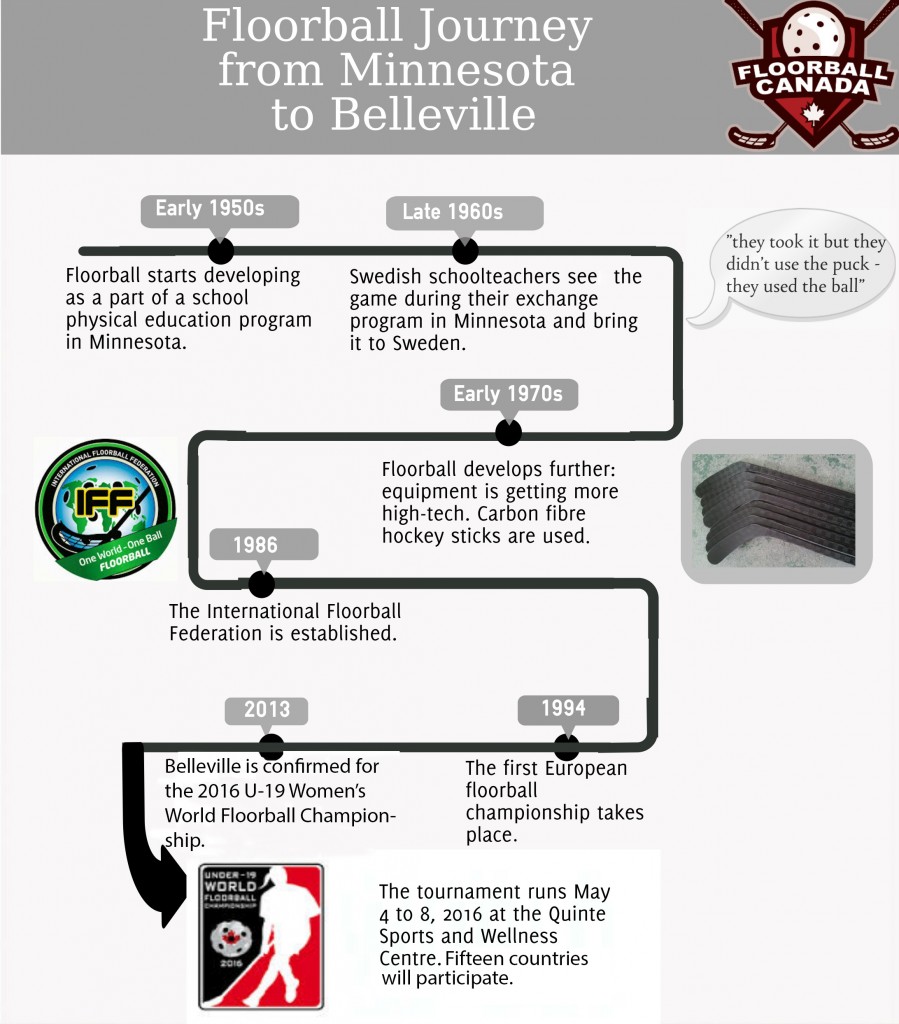Floorball: a perfect game for Canadians
BELLEVILLE – The world is coming to Belleville for the Women’s Under-19 Floorball World Championship in 2016. But what exactly is floorball?
Tedd Crawford, a phys-ed teacher at Moira Secondary School and the coach of the Canadian U-19 women’s floorball team, says the best way to describe it is: it’s hockey on a basketball-style court that borrows a lot of rules from basketball. There are no offsides, so you don’t have to worry about a line – the whole court is available to play on all the time.
“It’s played five on five and a goalie, so you can change on the fly. You can make substitutions as you go, just like hockey,” he said.
Floorball is played with a carbon fibre stick that has a perforated plastic blade. The hard ball weighs 23 grams and has 26 holes in it; you can shoot it up to 200 km/h, Crawford said.
The game is very easy to play, he said. “It’s a perfect game for Canadians because lots of Canadians play hockey – it’s very similar.”
A major difference between floorball and ice hockey is that the goalies do not have a stick and don’t wear gloves. They need to catch the ball using their hands and must pass it by throwing or rolling it to a teammate.
The sport was developed in Minnesota in the 1950s when some people were trying to play an indoor version of hockey, Crawford said. Initially it was played with a puck.
In the late 1960s, a bunch of Swedish teachers doing an exchange program in Minnesota saw the game as a good way to play hockey inexpensively, he said, so they implemented** the game but didn’t use the puck – they used a ball instead.
The game started getting more popular in the early 1970s. The equipment was getting more high-tech at that time. The original sticks, in comparison to today’s, were very much like those in ice hockey. Today, floorball sticks have the same shape as hockey sticks but their blade is perforated, but they are, like hockey sticks, made of carbon fibre that allows players to shoot the ball very hard.
When the International Floorball Federation was founded in 1986, the sport was played in mostly Nordic countries, Japan, and several parts of Europe. By 1990, floorball was recognized in seven countries; and by the time of the first European Floorball Championships in 1994, that number had risen to 14.

Crawford got acquainted with floorball when he was in Sweden in 2007.
Later, “I ended up getting hired at a high school in Belleville to run a hockey program here. And I brought a floorball aspect into the course that I was teaching, and students really liked it,” he said.
A year and half after he started his career at the Belleville school in 2008, Crawford was asked by the head coach of the junior national men’s team, David Jansson, to be an assistant coach at the 2011 Floorball World Championship in Germany. Once the tournament was over, Jansson suggested creating a women’s U-19 floorball program. Crawford asked five girls he was coaching at school and they agreed.
“We started from five girls, and now we have hundreds and hundreds to pick from,” he said.
In 2012 during the International Floorball Federation conference in Prague, Crawford and Brett Davis, a Belleville teacher, discuss the possibility of Canada hosting the world championship in the near future with the vice-president of the IFF.
“We were not even actually going to submit a bid,” Crawford said. “We were there just to get information, and when we had an opportunity we took it, and everybody was excited about the fact that we might bid on the world championships.”
In 2012 Crawford and Davis put in a formal bid for Belleville to host the 2016 U-19 Women’s Floorball World Championship. It took them three months to put everything together for the bid, he said. They spoke with various levels of government, asking about partnering with different organizations in order to put forward a solid bid. During the IFF meeting in Helsinki, the federation was deliberating over two bids, one from Swaziland and one from Belleville. Belleville won the voting.
“We were very, very excited. Since then we’ve had 2½ years to get ready, and with 13 months to go, we are on our final stretch,” the coach said.
The tournament runs May 4 to 8, 2016, at the Quinte Sports and Wellness Centre. Teams from 15 countries will participate in the championship.
 Print This Post
Print This Post







